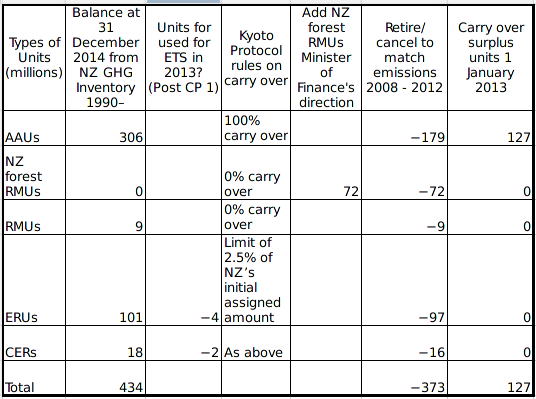 New Zealand’s new Minister for Climate Change, Paula Bennett, has just confirmed New Zealand will be “carrying forward” 127 million “Hot Air” emissions units (or offsets) under Kyoto Protocol rules. These units mostly do not represent a tonne of carbon dioxide equivalent reduced somewhere else and yet the Government intends to use them to allow New Zealand’s greenhouse gas emissions to continue to increase.
New Zealand’s new Minister for Climate Change, Paula Bennett, has just confirmed New Zealand will be “carrying forward” 127 million “Hot Air” emissions units (or offsets) under Kyoto Protocol rules. These units mostly do not represent a tonne of carbon dioxide equivalent reduced somewhere else and yet the Government intends to use them to allow New Zealand’s greenhouse gas emissions to continue to increase.
On Thursday 17 December 2015, Ms Bennett released a statement stating that New Zealand had met its 2008 to 2012 Kyoto Protocol emissions reduction target and was well on the way to meeting the 2013 to 2020 target.
The Minister’s statement linked to four reports on the Ministry for the Environment’s website;
- the Biennial report and net position snapshot 2015,
- the Biennial Report to the United Nations Framework Convention on Climate Change,
- the Report upon expiration of the additional period for fulfilling commitments by New Zealand and finally
- the updated Latest update on New Zealand’s 2020 net position.
In two scathing posts last week, blogger No Right Turn assessed the dubious use of the Ukrainian and Russian units derived from — of all things — coal stockpile projects; Climate change: A policy based on fraud and Climate change: How bad is NZ’s climate fraud?.
My previous estimate of the amount of surplus units likely to be used was 86 million units. The reports confirm the number to be 127 million units. I did a back-of-envelope calculation to relate the numbers of units cancelled (to match 2008-2012 emissions) and the numbers left over as ‘surplus’ which may be carried forward.

The updated Latest update on New Zealand’s 2020 net position explicitly confirms that New Zealand is ‘re-using’ the surplus units in assessing compliance with the 2020 target of a 5% reduction in emissions from a 1990 gross emissions base. So we will ‘meet’ the 2020 target in spite of projected increases in both gross emissions and net emissions. Gross emissions in 2020 are estimated to be 83 million tonnes, or 24% higher than 1990’s 67 million. Net emissions in 2020 are estimated to be 59 million tonnes, or 24% higher than 1990’s 38 million tonnes.
Manipulating accounting rules like this — so that an adverse trend is systematically misrepresented is as its opposite, a positive trend — is the text-book definition of creative accounting. I agree with No Right Turn that this is another example of New Zealand’s completely unethical climate change policy.

Paula Bennett has a history of exaggerating the numbers, so is perfectly suited to the role of spinning how great this governments useless emissions trading scheme is.
http://www.3news.co.nz/politics/bennetts-job-numbers-dont-add-up–ardern-2012111412#axzz3uzetgvwx
The words “fraud” and “laundering” spring immediately to mind.
Being complicit in these illegal activities would normally render a person responsible a term in jail. I guess it’s ok if it is a government however. /sarc
The result of these dubious manipulations and the laundering of hot air Units bought for the price of a cup of coffee will mean that we have at least another 2 years or more of BAU and increasing emissions – enough to get us through the next election – so I guess its alright then.
All due respect to the honorable minister but her qualifications in climate science or any related subject are what. ?????????
I suspect the fact that she is not qualified in any way for the portfolio is the reason she now has it. `Here is what you say Paula. No don`t think about it, just say this and smile`.
But then who else in government is qualified. ??? If they were we would not have the absolute sham policy to endure.
Paula Bennett has a degree in social work (obtained when she was on a benefit).
Nick Smith has a degree in civil engineering, which is at least somewhat more science based. But they wouldn’t give climate change to Nick Smith. He might actually want to do something.
The reason Russia and the Ukraine had so many credits issued is that the USSR collapsed in 1990 there was a huge drop in CO2 output compared to 1997 when the system started. Its this fictional saving that the NZ government is using. The UN is not that stupid and will slowly bring NZ into line and we will have to start behaving properly and reduce actual emissions which we can do quite easily.
There is more to the Ukraine credits than that Bob – some very shonky dealings:
http://www.theguardian.com/environment/2015/aug/24/kyoto-protocols-carbon-credit-scheme-increased-emissions-by-600m-tonnes
and
http://www.economist.com/node/16944921?zid=300&ah=e7b9370e170850b88ef129fa625b13c4
These were some of the “Credits” NZ was buying up with great alacrity
Reading this so very late (blame post-Paris exhaustion that turned into a summer holiday). So the big question is about our “ratification” of the KP’s CP2. We are “ratifying” it but without inscribing our commitment into the KP’s Annex B. A Claytons ratification, shall we say. One where we ratify, but don’t let our numbers be counted or measured, but which allows us to use and carry over hot air units. I don’t know how we can get away with this.
Hi Cindy
Welcome back. Yes exactly the statement about ratifying the Doha amendments to the Kyoto Protocol was back on 1 December 2015. Easy to ratify when you made no commitment. I managed to double book myself for one of those Jonathan Boston-organised Victoria University talks about COP21. But if I had made it, my question for MFAT climate envoy Jo Tyndall would have been; “Please name one other Kyoto Annex B country that won’t have a binding Kyoto target but will account for it’s 2013 to 2020 voluntary UNFCCC pledge with the Kyoto Protocol rules”.
Also, the Government seem determined to have another farcical NETS consultation while we are on holiday.
Jo Tyndall specifically told a delegation meeting in Paris that hot air would NOT be traded.
Then there’s the Westpac report on Paris and NZ Economy, out last week, that not only warns that agriculture being left out of the ETS is effectively a subsidy, but also states “a framework will need to be in place to ensure that carbon units traded internationally represent a genuine reduction in global emissions.”
Interesting report. Definitely not complimentary about Govt policy. http://www.westpac.co.nz/assets/Business/Economic-Updates/2016/Bulletins-2016/The-Paris-Agreement-February-2016.pdf
Cindy, I had heard through the grapevine that Jo Tyndall had said there would be no “trading” of the surplus units.
If we challenged her on that statement, I am sure she would say “using the surplus units to comply with NZ’s national 2013 to 2020 target (pledged under the UNFCCC, but accounted for under the Kyoto Protocol rules) is not “trading”. And it’s permitted by the Kyoto Protocol rules.” In other words, semantics and definitions.
However, in 2014, Treasury was in favour of flogging the surplus units off on the international markets. See this Treasury Aide Memoire on page 3.
Exactly – in other words “laundered”